Skin disorders and exposures
There are many ways that skin can be exposed to substances at work can harm the skin and cause disease. Some chemicals that come into contact with the skin can be absorbed and cause disease in other areas of the body.
Find out more about how to stay safe.
Skin exposure can occur through contact with cleaning products, oils, paints, adhesives and foodstuffs. It can also happen when work activities generate contaminants such as welding fumes, wet cement and wood dust.
Some chemicals that come in contact with the skin can be absorbed and cause disease in other areas of the body.
The skin can also be damaged by frequent or prolonged contact with water. Work involving more than 20 hand washes per shift or having wet hands for more than two hours per shift is known as wet work.
Industries with higher risk of skin exposure include:
- food services
- construction
- cleaning and maintenance
- hairdressing and beauty therapy
- health and community care
- metal working
- motor vehicle repair
- printing.
Seek medical advice for skin conditions as a result of occupational exposure. Severe allergic reactions of the skin may require immediate medical attention.
Health effects
The skin is an important organ that acts as a two-way barrier to protect the body from the outside world.
Some contaminants can pass easily though intact skin and enter other parts of the body. Broken skin (e.g. rashes, cuts, and scratches), very dry skin and skin that is frequently wet and dried is at increased risk of absorbing contaminants.
Frequent wetting and drying or use of alcohol based hand sanitisers can strip the skin of fats, making it dry and more vulnerable.
There are four main types of contaminants that can harm the skin:
| Contaminant type | Potential harm |
|---|---|
| Corrosives | Burns |
| Irritants | Irritant contact dermatitis |
| Sensitisers | Allergic contact dermatitis |
| Those that cause other diseases | Skin infections |
Common work-related skin diseases
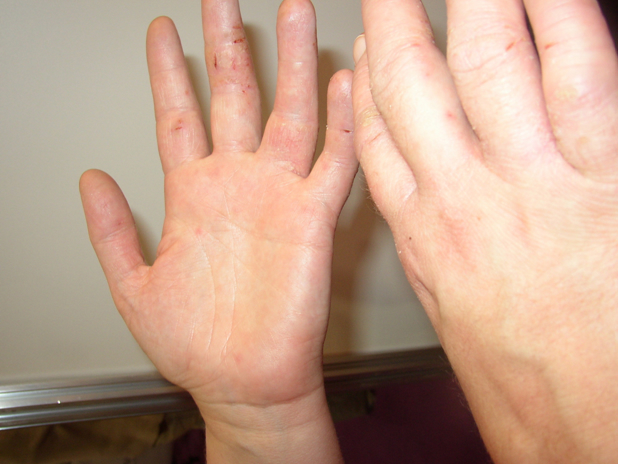 | Irritant contact dermatitis from excess washingIrritant contact dermatitis can occur quickly from exposure to a strong irritant or develop more slowly after repeated exposure to a mild irritant. It can also be caused by wet work. Irritant contact dermatitis happens at the area of skin where contact occurred. Examples of contaminants that cause this skin condition are solvents, oils, acids and detergents. |
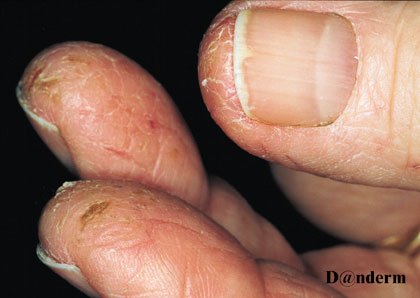 | Allergic contact dermatitis from garlicAllergic contact dermatitis occurs when the body becomes sensitive to a contaminant over time. This can happen over weeks, months or years of exposure. After sensitisation has occurred even very small exposures can cause allergic skin reactions within 24 hours. This allergy will stay with the affected person for the rest of their life and the only way to control symptoms is to prevent further exposure. Common examples of allergy causing contaminants are nickel, hair dye, cement, leather, and certain food stuffs. |
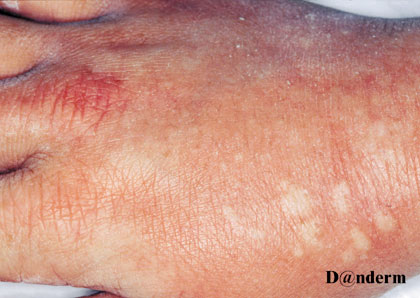 | Allergic contact dermatitis on a hairdresser's handsContact urticaria may occur immediately after contact with a substance that is an irritant or sensitiser. Contact urticaria is caused by an irritant or allergic reaction to a substance and may present as red flaring, itching, swelling and welts (hives) of the skin that occurs soon after exposure. If the urticaria is caused by an allergic reaction, other symptoms such as sneezing, a runny nose or wheezing may also occur. In severe cases there may be difficulty with breathing and anaphylactic shock, which is life-threatening. Common examples of substances that can cause contact urticaria include natural latex rubber found in latex gloves, hairdressing bleach and seafood. |
Image file source: UK HSE Image library
Skin absorption
Some contaminates can be readily absorbed through the skin and cause health effects in other areas of the body. Examples include:
| Contaminant | Area affected |
|---|---|
| Aromatic amines | Bladder (cancer) |
| Mineral oils | Scrotum (cancer) |
| Benzene | Blood (leukemia) |
| Organophosphates | Nervous system (muscle weakness) |
Managing exposure
Identification
Identify processes that may involve skin exposures. Safety data sheets, technical data sheets and labels on products are a good source of information.
View some examples of irritants and sensitisers that workers can be exposed to:
Occupation | Irritants that can cause irritant contact dermatitis | Sensitisers that can cause allergic contact dermatitis |
Abattoir workers | Acids, alkalis, detergents, waste products, wet-work | Animal proteins, formaldehyde, latex gloves, nickel |
Cleaners | Detergents, other cleaning products, solvents, wet-work | Formaldehyde, germicidal agents |
Construction workers | Cement, dusts, solvents, sand, wet-work | Cement, chromium, cobalt, epoxy resins, nickel, resins, wood dust, isocyanate based products |
Cooks and caterers | Acids, alkalis, bleaching agents, detergents, vegetable juices, wet-work | Some flavours, formaldehyde, garlic, sodium metabisulphite, spices |
Hairdressers | Bleaching agents, dyes, perming solutions, shampoos, wet-work | Dyes, nickel, persulphates, perfumes, latex gloves, amine based chemicals |
Health care workers | Disinfectants, detergents, wet-work | Latex gloves, local anaesthetics, antibiotics, antiseptics, formaldehyde, glutaraldehyde |
Metal workers | Cutting fluids, solvents, metal shavings/dust, wet-work | Additives/preservatives in cutting fluids, chromium, nickel |
Motor vehicle repairers | Aggressive hand cleaners, fuels, oils, paints, solvents | Chromium, cobalt, epoxy resins, nickel |
Printers | Solvents | Colophony, formaldehyde, metals in inks & resins, hardeners, turpentine |
Fishing, trawling or seafood handling | Fish products, wet-work | Seafood |
Control the risks
Stop or reduce the exposures:
Where possible, stop using products or doing work activities that can harm the skin or cause disease
- Use encapsulated machines or automated equipment such as dishwashers or parts washers.
Use a less harmful material or substance
- A less concentrated substance
- A water-based product instead of solvent based product.
Use products in a form that is less likely to be absorbed into the skin
- Instead of liquids or powders use pellets or granules
- Follow the manufacturers or suppliers suggested dilution rates for chemicals.
Cover cuts as these may provide a route of entry for substances.
Control the exposures:
Separate workers from the hazard.
Enclose the process, handling system or contaminant
- Use a glove box
Create a safe working distance between the skin and contaminants
- Use tools and equipment such as tongs, hooks and scoops.
Prevent incidental contact with contaminants- Use good housekeeping practices to ensure surfaces are kept clean.
Protect the skin:
Good skin care including, proper hand washing, hand drying and using a skin lotion to moisturise the skin and prevent drying will help to maintain the skin's integrity and reduce the risk of irritant and allergic contact dermatitis developing.
Personal protective equipment (PPE)
PPE may be needed if it is not possible to avoid skin contact using other control measures. Several PPE items may be needed to protect the worker. How much depends on the level of potential contamination and can include a combination of overalls, goggles, face shield, respirator, gloves and/or boot covers.
The personal protective equipment film shows how to correctly and safely put on, wear and remove PPE. It also shows how to dispose of it.
Gloves
No one type of glove will suit every work task, every contaminant and every worker.
When choosing the right glove, consider:
- the work activity
- if dexterity is required for the task
- the type of glove for the process (short cuff or arm length)
- the length of time it takes to conduct the task
- whether the task involves chemical splashes or immersion
- whether cotton glove liners are required to reduce sweating in hot conditions
- the worker
- provide a range of different sizes to fit individual workers
- minimise the risk of latex allergies by choosing powder free non-latex gloves
- the contaminant
- the breakthrough time of the specific chemical
- the potential lifespan of the gloves
- a glove selection guide.
Glove manufacturers often produce selection guides that can be used to choose the most suitable glove. The Ansell 8th Edition Chemical Resistance Guide and the Prochoice Hand Protection Guide are two examples of manufacturer's glove selection guides.
Before gloves are worn, ensure they are inspected for integrity, remove and replace gloves if they appear damaged or break-through occurs.
Once gloves are removed it is important to wash hands in case of accidental contamination.
View some examples of correct glove selection for different work activities
Chemically cleaning metal parts in an acid bath
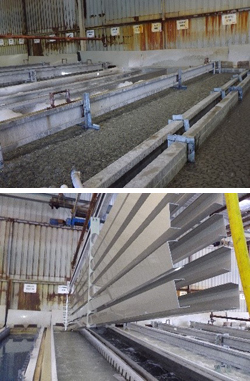
Skin hazard:
- Chemical splashes causing burns to skin.
How to prevent exposure:
- use racks to hold metal parts
- have lifting equipment to dip and remove product from acid baths
- use a rinse bath after dipping to prevent handling items coated in chemicals.
Personal protective equipment required:
- Chemical resistant face shield, apron and boots.
Glove Selection:

Gloves that have the EN 374 symbol and can provide splash protection against acids, Heavy duty butyl rubber chemical resistant gloves would meet the requirement.
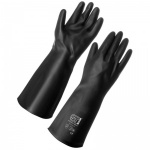
Salon hair washing/hair dying
Skin hazard:
- hair dyes (p-phenylenediamine)
- wet work.
How to prevent exposure:
- task rotation
- following manufacturer's instructions on correct use of chemicals
- don't reuse disposable gloves.
Glove selection:

EN374 compliant disposable nitrile gloves.
Training
A worker training program can increase awareness of specific skin exposure risks in the workplace and highlight the importance of protecting the skin. Topics to cover include:
- specific skin hazards in the workplace
- health effects of exposure to contaminants
- controls used to minimise skin exposure
- early warning signs of skin disease
- first aid procedures for chemical contact or splashes
- effective hand washing techniques and personal hygiene principles
- how to correctly put on and take off single use and reusable gloves.
Maintaining and reviewing the controls
You may already have the right controls in place to protect workers skin, but are they working properly?
- When were the controls last checked?
- Are controls used by workers when needed?
- Is there a better control that could be implemented?
Health monitoring
Some chemicals requiring health monitoring can be readily absorbed through the skin. You must ensure health monitoring is provided to workers who are carrying out ongoing work using, handling, generating or storing certain substances (such as chromium, creosote and poly-aromatic hydrocarbons) and there is a significant risk to the worker's health because of exposure. Further guidance on determining significant risk can be found in Safe Work Australia's Health monitoring for exposure to hazardous chemicals - Guide for persons conducting a business or undertaking.
Resources
- Work Health and Safety Regulation 2011
- How to manage work health and safety risks Code of Practice 2021 (PDF, 0.65 MB)
- Managing risks of hazardous chemicals in the workplace Code of Practice 2021 (PDF, 1.21 MB)
- Managing the work environment and facilities Code of Practice 2021 (PDF, 0.57 MB)
- Abrasive blasting Code of Practice 2021 (PDF, 1.13 MB)
- Spray painting and powder coating Code of Practice 2021 (PDF, 1.18 MB)
- Personal Protective Equipment film
- Ansell Chemical Resistance Glove Guide
- ProChoice Hand Protection Guide